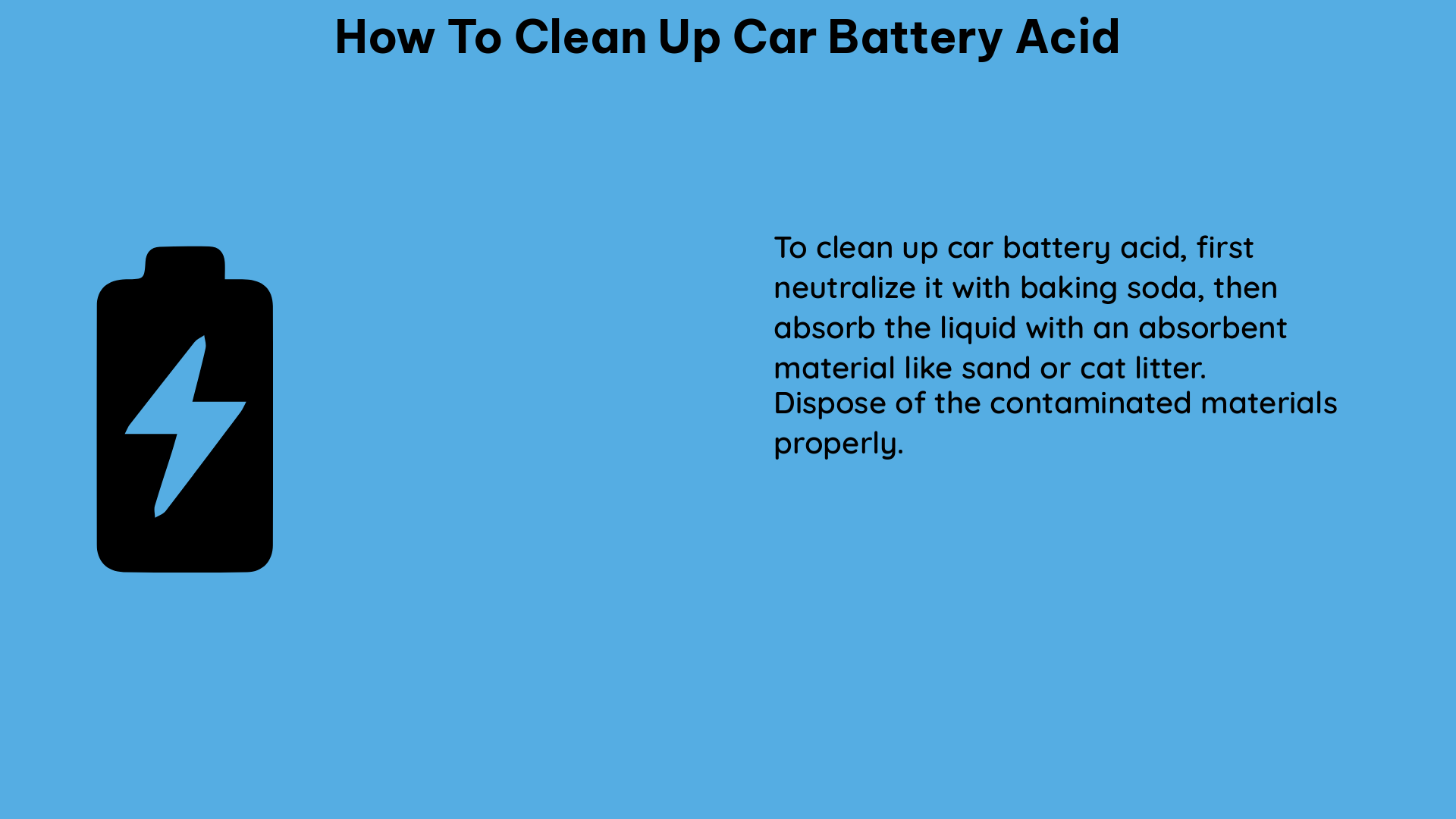When a car battery leaks or spills its acidic contents, it can pose a serious threat to your health, your vehicle, and the environment. Proper cleanup and disposal of car battery acid are crucial to mitigate the risks and ensure the safety of everyone involved. This comprehensive guide will walk you through the step-by-step process of effectively cleaning up a car battery acid spill, as well as provide valuable tips to prevent such incidents in the future.
Assess the Risk
The first step in cleaning up a car battery acid spill is to assess the potential risks. Sulfuric acid, the primary component of car battery acid, is a highly corrosive substance that can cause severe burns to the skin and eyes, as well as respiratory issues if inhaled. It’s essential to determine the extent of the spill and whether it poses a threat to humans, animals, plants, or the surrounding environment.
If the spill is significant or poses a significant risk, it’s crucial to contact emergency response services immediately. They can provide guidance on the appropriate course of action and ensure the safe containment and disposal of the hazardous material.
Wear Protective Gear

Before attempting to clean up the spill, it’s crucial to don the proper personal protective equipment (PPE). This includes:
- Nitrile or rubber gloves to protect your hands from direct contact with the acid
- Safety goggles or a face shield to prevent splashes from entering your eyes
- A respirator or N95 mask to avoid inhaling any noxious fumes
Wearing the appropriate PPE will minimize the risk of exposure and ensure your safety during the cleanup process.
Neutralize the Acid
The next step is to neutralize the car battery acid. The method you use will depend on the type of battery involved.
For a lead-acid (sulfuric acid) battery:
– Mix a solution of 1 pound of baking soda per 1 gallon of water.
– Apply the baking soda solution to the spill using a cloth or sponge, taking care to avoid splashing or spreading the acid.
– The baking soda will react with the sulfuric acid, neutralizing it and creating a harmless salt solution.
For an alkaline (nickel-cadmium or lithium-ion) battery:
– Use a mild acid, such as lemon juice or vinegar, to neutralize the alkaline spill.
– Dab the affected area with a cloth soaked in the acidic solution.
– For any stubborn alkaline leakage, use a toothbrush to gently scrub the area.
Ensure that the neutralization process is complete by checking the pH of the affected area. The ideal pH range is between 6.0 and 8.0, indicating a neutral state.
Clean Up the Spill
Once the acid has been neutralized, use clean cloths and sponges to soak up all the remaining liquid. Place the contaminated materials into a plastic garbage bag to prevent further contamination.
It’s essential to avoid using a vacuum cleaner or sweeping the area, as this can spread the acid and create airborne particles that can be inhaled.
Disinfect the Area
After the spill has been cleaned up, disinfect the affected area using a solution of mild detergent or vinegar mixed with water. This will help to remove any residual acid and ensure the area is safe for future use.
Proper Disposal
The final step is to properly dispose of the leaking battery, the used cloths, sponges, and any other contaminated materials. Car battery acid is considered hazardous waste and must be handled accordingly.
Place the leaking battery and the contaminated materials into two doubled-up trash bags and seal them securely. Contact your local household hazardous waste (HHW) facility or municipal government to determine the appropriate disposal method in your area.
Preventing Battery Acid Spills
To avoid the hassle and potential dangers of a car battery acid spill, it’s essential to take preventive measures. Here are some tips:
-
Store Batteries Properly: Keep car batteries in a dry, cool location away from direct sunlight and heat sources. Avoid storing them on metal surfaces, as this can cause short circuits and leaks.
-
Handle Batteries with Care: Be cautious when handling car batteries, and avoid dropping or puncturing them, as this can lead to acid leaks.
-
Secure Battery Terminals: Cover the battery terminals with electrical tape or a terminal cover to prevent short circuits and potential spills.
-
Dispose of Batteries Properly: Never throw car batteries in the trash. Instead, take them to a recycling center or an approved collection site for proper disposal.
-
Inspect Batteries Regularly: Regularly check your car’s battery for signs of damage or leakage, and replace it if necessary to prevent future spills.
By following these preventive measures and the step-by-step cleaning process outlined in this guide, you can effectively clean up a car battery acid spill and minimize the risks to your health, your vehicle, and the environment.
References

The lambdageeks.com Core SME Team is a group of experienced subject matter experts from diverse scientific and technical fields including Physics, Chemistry, Technology,Electronics & Electrical Engineering, Automotive, Mechanical Engineering. Our team collaborates to create high-quality, well-researched articles on a wide range of science and technology topics for the lambdageeks.com website.
All Our Senior SME are having more than 7 Years of experience in the respective fields . They are either Working Industry Professionals or assocaited With different Universities. Refer Our Authors Page to get to know About our Core SMEs.